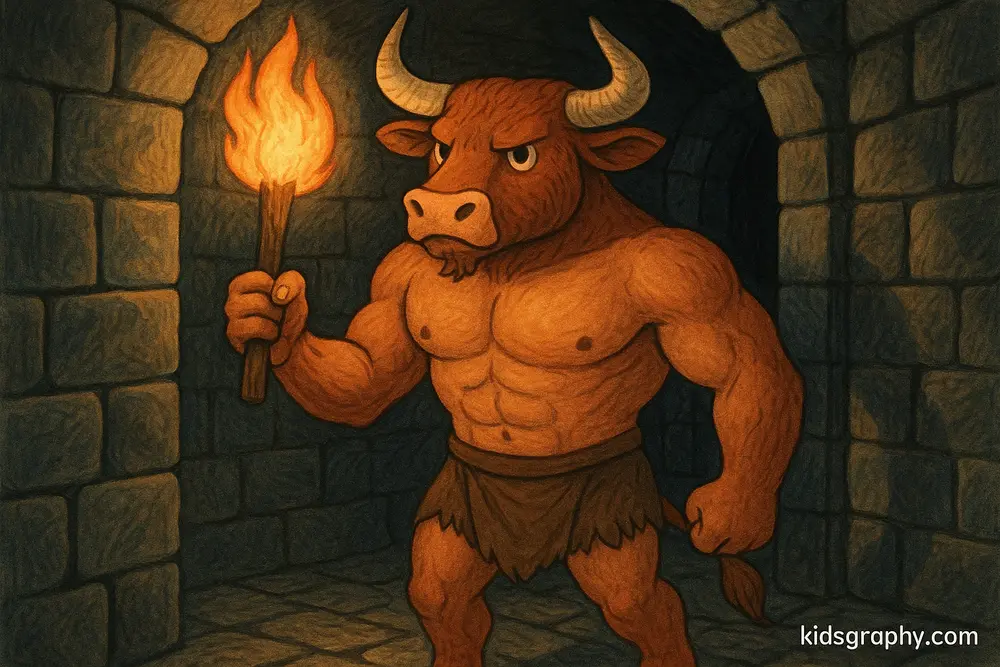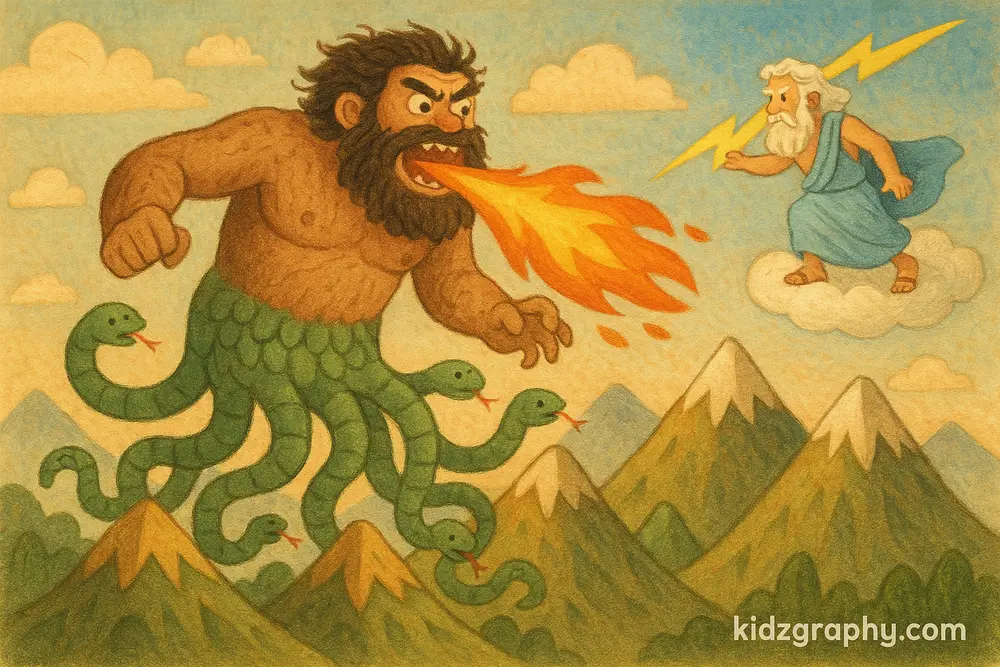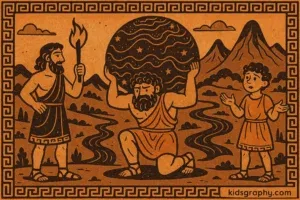In the world of Greek mythology, monsters were more than just scary beasts—they were tests, punishments, and guardians of great secrets. Some guarded treasure. Others were sent by gods to destroy. Many were half-human, half-beast. All had a place in the rich storytelling of ancient Greece.
This exploration will delve into the realm of Greek mythology’s most renowned and perilous monsters, examining the reasons for their enduring legacy.
Read More: Ares in Greek Mythology: God of War and Fury
Medusa – The Snake-Haired Gorgon
Medusa is one of the most well-known female monsters in Greek mythology. She had hair made of snakes, and anyone who looked into her eyes turned to stone.
Medusa wasn’t always a monster. She was once a beautiful woman, but after angering the goddess Athena, she was cursed. Her face became terrifying, and her stare became deadly.
Perseus, a brave hero, was sent to defeat her. He used a mirrored shield to avoid looking directly at her and cut off her head. Even after death, her head had power—used later to protect people in battle.
Read More: Sirens in Greek Mythology: Deadly Voices of the Sea
The Chimera – Fire-Breathing Beast
The Chimera was a fearsome creature with the head of a lion, a goat’s head on its back, and a serpent for a tail. It could breathe fire and destroyed everything in its path.
This monster was so deadly that King Iobates asked the hero Bellerophon to slay it, hoping he would fail. But Bellerophon, riding the winged horse Pegasus, struck it from the air with a spear tipped in lead. The fire melted the lead, and the Chimera died.
The Chimera remains a symbol of terrifying mixed creatures in Greek mythology.
Read More: Tartarus in Greek Mythology: Prison of the Gods
Scylla and Charybdis – Sea Monsters of Terror
Sailors feared many things, but nothing more than Scylla and Charybdis. These two monsters guarded opposite sides of a narrow sea passage.
- Scylla was once a beautiful nymph, but she was transformed into a monster with six long necks and twelve legs. She snatched sailors from ships and ate them.
- Charybdis was a massive whirlpool that swallowed the sea, dragging ships underwater.
In the Odyssey, Odysseus had to sail between them, choosing which danger to face. These sea monsters are unforgettable examples of Greek mythology monsters in the ocean.
Read More: Perseus in Greek Mythology: Hero, Slayer of Medusa
The Minotaur – Half-Man, Half-Bull
One of the most famous half-human monsters in Greek mythology is the Minotaur. He had the body of a man and the head of a bull. He lived in a dark, twisting maze called the Labyrinth, built by the inventor Daedalus.
The Minotaur was fed young people as punishment to keep him calm. But one day, Theseus, a prince of Athens, entered the maze with a plan. Using a string to find his way out, he defeated the monster and ended the curse.
The Minotaur’s story reminds us of courage and cleverness in the face of fear.
Read More: Hyperion in Greek Mythology: Titan of Heavenly Light
The Nemean Lion – Beast of Unbreakable Skin
This lion was no ordinary animal. Its golden fur couldn’t be pierced by weapons, and it terrorized the land of Nemea.
Heracles (Hercules) was sent to kill the lion as his first labor. He fought it with his bare hands and choked it to death. Afterward, he used its claws to cut its own skin and wore the hide as armor.
The Nemean Lion is a symbol of brute strength and unbeatable monsters.
Read More: Athena in Greek Mythology: Goddess of Wisdom & War
Typhon – The Father of All Monsters
If one monster could destroy all of Mount Olympus, it was Typhon.
He was taller than mountains, with snake legs and fire-breathing heads.
The gods fled when Typhon attacked. But Zeus returned and battled him, finally winning by trapping Typhon under a mountain. Some say that mountain is Mount Etna, which still spits fire as a volcano today.
Typhon was the most powerful monster in Greek mythology, and his children included many other famous beasts.
Read More: Hermes in Greek Mythology: Messenger of the Gods
Echidna – Mother of Monsters
If Typhon was the father of monsters, then Echidna was the mother. She was part woman, part snake, and lived in a cave.
With Typhon, she gave birth to:
- Cerberus (three-headed dog)
- Hydra (many-headed serpent)
- Chimera (lion-goat-snake)
- Sphinx (lion woman who gave riddles)
Echidna didn’t fight heroes herself, but her children did. She was the source of many famous monsters in Greek mythology.
Read More: Pandora in Greek Mythology: The First Woman’s Curse
The Lernaean Hydra – The Regenerating Serpent
The Hydra was a deadly water serpent with multiple heads, and each time one was cut off, two more grew back in its place. It lived in the swamp of Lerna, poisoning the air and killing anything nearby. As one of his Twelve Labors, Heracles (Hercules) was sent to slay it.
With the help of his nephew Iolaus, Heracles burned each stump after cutting off a head, stopping them from growing again. He dipped his arrows in the Hydra’s poisonous blood, making them lethal in future battles.
The Hydra represents the idea that some problems grow worse when you try to fight them the wrong way—an important lesson in both myth and life.
Read More: Persephone in Greek Mythology: Queen of the Underworld
Cerberus – The Three-Headed Guard Dog of the Underworld
Cerberus was the giant three-headed dog that guarded the gates of the Underworld. He made sure no souls escaped and no living person entered without permission.
He belonged to Hades, god of the dead. Cerberus had a serpent tail and a mane of snakes, and he could frighten even the bravest heroes.
In his final labor, Heracles was asked to bring Cerberus up from the Underworld without using weapons. With strength and courage, he did it—and returned Cerberus unharmed.
Cerberus is one of the most recognizable monsters in all of mythology, symbolizing loyalty, protection, and the boundary between life and death.
Read More: Titans in Greek Mythology: Gods Before Olympus
The Harpies – Wind Spirits Turned Monsters
Originally spirits of storms, the Harpies became feared monsters with the faces of women and the bodies of birds.
They were known to steal food and torment mortals. In the myth of Phineus, the Harpies kept snatching his meals before he could eat. The hero Jason and his crew helped chase them away during the voyage of the Argonauts.
Harpies are mythological representations of both the fear of divine wrath and insatiable hunger, commonly symbolizing torment orchestrated by the gods.
Read More: Cronus in Greek Mythology: Titan of Time and Power
The Sphinx – Riddler of Thebes
The Sphinx had the body of a lion, wings of a bird, and face of a woman. She lived near the city of Thebes, where she challenged travelers with a riddle:
“What walks on four legs in the morning, two at noon, and three in the evening?”
Those who failed to answer were killed on the spot.
Only Oedipus solved the riddle: “Man,” he said, “crawls as a baby, walks as an adult, and uses a cane in old age.” The Sphinx, defeated, threw herself from a cliff.
The Sphinx represents wisdom, mystery, and danger—all rolled into one.
Why Monsters Matter in Greek Mythology
Monsters in Greek mythology weren’t just enemies. They often symbolized real fears—of the sea, death, the unknown, or human weakness.
- The sea monsters showed the dangers of travel.
- The hybrid beasts reflected nature’s unpredictability.
- The fire-breathing or regenerating ones showed how some problems grow if left unsolved.
Heroes had to face these monsters not just with strength—but with cleverness, patience, and help from others.
More Stories: Greek Mythology Monsters
FAQ: Greek Mythology Monsters
Monsters in Greek mythology are powerful, often dangerous creatures used to challenge heroes, guard treasures, or represent natural fears like storms and death.
Typhon is considered the most powerful. He was a giant with multiple heads and fire-breathing powers who once challenged even Zeus.
Famous female monsters include Medusa, Scylla, the Harpies, the Sphinx, and Echidna, who was the “Mother of Monsters.”
Not always. While many were destructive, some like Cerberus were simply guardians. Many monsters symbolized challenges rather than evil.
Scylla, Charybdis, and the Hydra are well-known sea monsters from antiquity, feared by sailors and prominent in epics such as The Odyssey.











